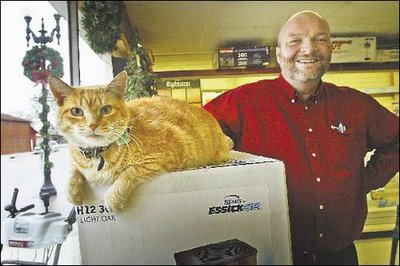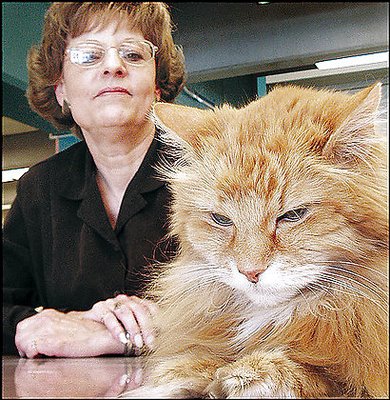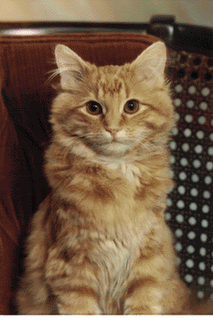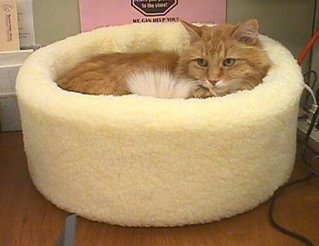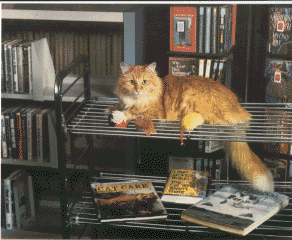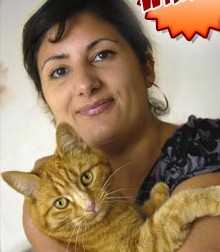Heroes and Victims: Sixteen Special Cats to Remember from the Year 2006
"God requires that we assist the animals when they need our help."As the year rapidly draws to a close it is once again time to pause and remember some of the cats that have tugged at the heartstrings of cat lovers around the world during the past twelve months.
-- St. Francis of Assisi
Although far from being exhaustive, sixteen special felines have been selected for this year-end remembrance.
They range from felines that have performed spectacular feats of valor and those that have had narrow escapes on the one hand to still others that have been the victims of unspeakable acts of cruelty and unwarranted euthanasia on the other hand.
There are also cats that have had run-ins with the law and others who have, sadly, crossed the Rainbow Bridge.
1.) Chipper. Kitten Dies after Having Been Run Through a Wood Chipper.
 |
| Chipper |
Sans doute, the most heartbreaking story to come out of 2006 was the death in July of a tiny, ten-week-old orange and white kitten named Chipper who was run through a wood chipper in Boca Raton, Florida.
The kitten's front legs and neck were broken in the assault and he also sustained head and eye injuries.
He waged a valiant struggle to live but eventually succumbed to his massive injuries.
As far as it is known, the perpetrator of this horrendous crime has never been apprehended. (See Cat Defender post of July 13, 2006 entitled "Heroic Little Kitten, Fiendishly Run Through a Wood Chipper by Some Devil, Loses His Nineteen-Day Struggle to Live.")
2.) Fred. Undercover Cat Is Killed by Hit-and-Run Driver.
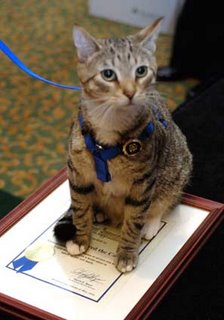 |
| Fred |
One of the true feline heroes of the year was a fifteen-month-old gray and yellow American Shorthair named Fred who went undercover in February to help the Brooklyn District Attorney's Office arrest a quack veterinarian.
Malheureusement, his owner allowed him to play in the busy streets of Howard Beach, Queens and he was struck and killed by a hit-and-run driver on August 10th.
Rescued from the street with a collapsed lung and suffering from pneumonia, his life almost ended then when shelter workers at first wanted to kill him. (See Cat Defender posts of February 14, 2006 and August 17, 2006 entitled, respectively, "Special Agent Fred the Cat Goes Undercover to Help Nab Quack Vet in Brooklyn Sting Operation" and "Brave Little Fred the Undercover Cat Has His Short, Tragic Life Snuffed Out by a Hit-and-Run Driver in Queens.")
3.) Lewis. Connecticut Tomcat Survives a Serious Brush with the Law.
 |
| Lewis and Ruth Cisero |
The feline that grabbed the most media attention in 2006 was Fairfield, Connecticut real estate agent Ruth Cisero's five-year-old longhaired, polydactyl tuxedo tomcat, Lewis.
Charged with attacking five women, he narrowly avoided the death penalty when a judge spared his life. He was nonetheless placed under permanent house arrest and Cisero was ordered to perform community service and placed on probation.
He is reportedly making the best of a bad situation by trying to adjust to being an indoor cat. (See Cat Defender posts of April 3, 2006 and June 26, 2006 entitled, respectively, "Free Lewis Now! Connecticut Tomcat, Victimized by a Bum Rap, Is Placed Under House Arrest" and "Lewis the Cat Cheats the Hangman but Is Placed Under House Arrest for the Remainder of His Life.")
4.) Mohre. German Cat Saves an Abandoned Infant.
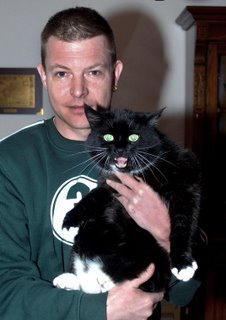 |
| Mohre and Dirk Prager |
On a cold April morning in Koln, Dirk Prager's jet-black cat Mohre inexplicably started meowing and pawing on the inside of the door.
When he refused to quiet down, Prager reluctantly got up and went to the door where he was shocked to find an abandoned newborn baby boy lying on his steps.
Christened Simon Sonnenschein by nurses at the hospital where he was immediately taken, he is alive today because of Mohre's timely intervention. (See Cat Defender post of April 21, 2006 entitled "Cat Named Mohre Saves Newborn Infant Abandoned in the Cold on a Doorstep in Koln.")
5.) Jack. Declawed Tomcat Trees a Bear.
 |
| Jack |
An orange and white, ten-year-old declawed tomcat named Jack from northern New Jersey is very possessive about his yard.
In fact, he is so territorial that he twice in one day treed a black bear. Not wanting any part of the pugnacious little feline, the bear quickly fled back into the woods. (See Cat Defender post of June 19, 2006 entitled "Irresponsible Cat Owner Allows Declawed Tomcat Named Jack to Tangle with Black Bear in Northern New Jersey.")
6.) Bamboo. Elderly Cat Survives a Vicious Attack by Hoot Owl.
 |
| Bamboo and Colleen Hamilton |
A diminutive fifteen-year-old cat named Bamboo was abducted from Colleen Hamilton's back porch in British Columbia in July by a hoot owl.
She somehow managed to escape but the ordeal cost her three broken legs, several puncture wounds, and a patch of fur.
Kudos are also in order for Hamilton who, unable to afford the around-the-clock veterinary care that Bamboo required, instead took two weeks off from work in order to nurse her beloved companion back to health. (See Cat Defender post of July 31, 2006 entitled "Fifteen-Year-Old Cat Named Bamboo Miraculously Survives Being Abducted and Mauled by a Hoot Owl in British Columbia.")
7.) Molly. A Black Cat Is Rescued from Walls of Greenwich Village Deli.
 |
| Molly |
An acoustics expert and a construction worker accomplished what the police and firemen had been unable to do when they pulled an eleven-month-old black cat named Molly from the walls of an English-style delicatessen in Manhattan's Greenwich Village in April.
After being trapped for two weeks, the valuable mouser was later treated to a sumptuous meal of bacon and sardines. (See Cat Defender post of April 20, 2006 entitled "Molly Is Finally Rescued After Spending Two Weeks Trapped Inside the Walls of an English Deli in Greenwich Village.")
8.) Piper. Kitten Survives a Stay in a Storm Drain.
 |
| Piper |
A six-week-old Manx kitten named Piper spent six scary days trapped in a Salinas, California storm drain in September before she was finally freed.
Having tried everything else, rescuers hit upon the idea of baiting a trap with fish and a bell and that did the trick. (See Cat Defender post of September 18, 2006 entitled "Rescuers Lure Manx Kitten Named Piper from a Storm Drain by Baiting a Trap with Mackerel and a Bell.")
9.) Neo. Texas Cat Makes an Unscheduled Trip to Colorado.
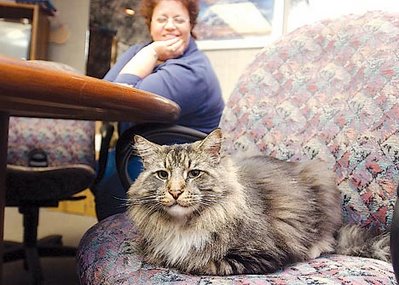 |
| Neo |
A friendly, longhaired brown cat named Neo wandered into a neighbor's moving van in Crowley, Texas and unexpectedly wound up in Longmont, Colorado in October.
Through the efforts of Golden Van Lines, however, he was soon returned to his rightful owners on an airplane. (See Cat Defender post of November 6, 2006 entitled "Trapped in a Moving Van for Five Days, Texas Cat Named Neo Is Finally Freed in Colorado.")
10.) Sneakers. Long-Lost Cat Is Reunited with Owner Thanks to a Microchip.
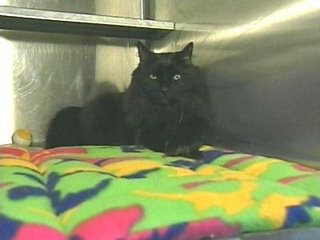 |
| Sneakers |
A longhaired black cat named Sneakers who disappeared from his home in Seattle in 1996 was reunited with his owner in April after he was discovered at a shelter in Sacramento.
The reunion was made possible by the fact that his owner had had the prescience to microchip him. (See Cat Defender post of June 12, 2006 entitled "Given Up for Dead, Sneakers Is Reunited with His Owner After Having Gone AWOL Ten-Years Ago.")
11.) Oliver Gatsby. A Russian Blue Becomes Embroiled in a Custody Battle.
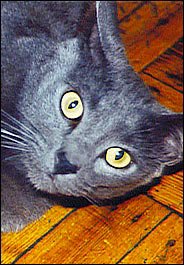 |
| Oliver Gatsby |
A pure-blood Russian Blue cat named Oliver Gatsby became the focus of a celebrated legal battle after he was adopted from a shelter by a Manhattan lawyer.
Unfortunately for her, his previous owner found out a year later that he was still alive and demanded that he be returned.
After much legal wrangling, the attorney relinquished her claim to the cat and he was returned to his previous owner. (See Cat Defender post of January 3, 2006 entitled "Manhattan Court to Rely Upon 1894 Dog Law to Decide Custody Battle over a Russian Blue Cat Named Oliver Gatsby.")
12.) Opie. Handicapped Feral Cat Finds a Home at a Tennessee Prison.
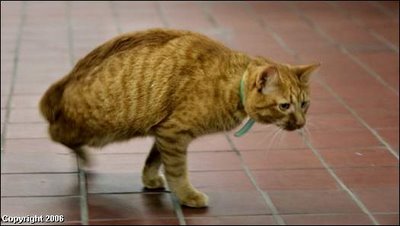 |
| Opie |
A three-legged, bobtailed cat named Opie has found a home in the laundry room of a Tennessee prison.
In doing so he has also won over the hearts of the inmates who live and work there. (See Cat Defender post of November 2, 2006 entitled "Three-Legged, Bobtailed Cat Named Opie Melts the Hearts of Hardened Criminals at Rural Tennessee Prison.")
13.) Zoe. A Texas Kitten Is Divested of Her Ears by Ailurophobes.
 |
| Zoe |
In yet still another act of revolting animal cruelty, a tiny kitten named Zoe from Kingsville, Texas had her ears cut off by ailurophobes in October.
She is recovering but her ears are gone forever. Equally troubling is the fact that law enforcement personnel in the Lone Star State do not take animal abuse cases seriously.(See Cat Defender post of October 27, 2006 entitled "Tiny Kitten Named Zoe Has Her Ears Cut Off by Fiends But Texas Police Do Not Seem to Care.")
14.) Tripod. A Vermont Cat Is Killed Off by Journalists He Befriended.
 |
| Tripod |
A faithful three-legged gray cat named Tripod, who for years had brightened the offices of The Caledonian Record in St. Johnsbury, Vermont, was killed off earlier this year because the journalists were too cheap and lazy to care for him in his old age.
If he had been given proper veterinary care, he might very well still be alive today.
The fact that he had struggled so hard to go on living after he had earlier lost a leg in a trap proves that he was a fighter. (See Cat Defender post of February 9, 2006 entitled "Newspaper Cat Named Tripod Is Killed Off by Journalists He Befriended in Vermont.")
15.) Dewey Readmore Books. Famous Library Cat Is Killed Off at Age 19.
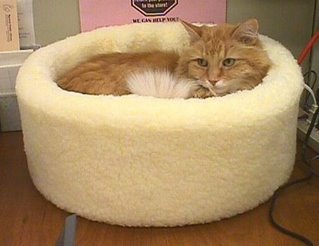 |
| Dewey Readmore Books |
In another example of man's ingratitude toward animals, the library in Spencer, Iowa recently killed off its famous feline, Dewey Readmore Books, at age nineteen.
Although the library had capitalized on his notoriety in order to fatten its coffers, it was unwilling to go to the added expense and bother of caring for him in his old age.
Worst still, his death was preceded by years of abuse, neglect, and exploitation. (See Cat Defender post of December 7, 2006 entitled "After Nineteen Years of Service and Companionship, Ingrates at Iowa Library Murder Dewey Readmore Books.")
16. Humphrey of 10 Downing Street, 1988-2006, Requiescat in Pace.
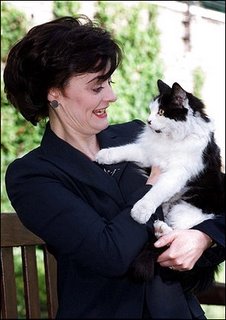 |
| Humphrey and Cherie Blair |
Humphrey, a longhaired tuxedo stray who for many years found a home at 10 Downing Street, passed away in March at the age of eighteen.
He was a fixture at the prime minister's residence during the tenures of Maggie Thatcher and John Major but the ailurophobic Cherie Blair gave him the boot.
This precipitate action prompted the Tories to demand proof from the Blairs that they had not done away with the famous feline.
Known as a proficient mouser, he is said to have been better at his job than Rentokill.
A Cabinet report made public in 2005 described him as a "workaholic who spends nearly all his time at the office, has no criminal record, does not socialize a great deal or go to many parties and has not been involved in any sex or drug scandals that we know of." (See Cat Defender post of April 6, 2006 entitled "Humphrey, the Cat from 10 Downing Street Who Once 'Read' His Own Obituary, Passes Away at 18.")
As special as these wonderful cats are, it is important to remember that there are millions of cats all over the world that are being abused and killed every day. Shelters and veterinarians exterminate them by the millions each year simply because they are either homeless or old.
Vivisectors, cloners, and purveyors of designer pets abuse and kill countless more of them. Ailurophobes, yobs, motorists, bird lovers, and wildlife advocates kill them for fun. Millions more die from hunger and the cold.
The time has come to end the abuse, torture, and killing of cats. Their lives and liberties are no less precious than those of humans and this self-evident truth should be codified in the laws of all societies.
St. Francis of Assisi once said that "God requires that we assist the animals when they need our help" and they have never needed it more than they do today.
Photos: Danny Ghitis of the South Florida Sun-Sentinel (Chipper), Alan Raia of Newsday (Fred), Brian A. Pounds of the Connecticut Post (Lewis and Ruth Cisero), Schwaiger of the Koln Express (Mohre and Dirk Prager), Suzanne Giovanetti (Jack), Erin Kelley-Gedischk of the Oak Bay News (Bamboo and Colleen Hamilton), WABC-TV, New York (Molly), SPCA of Monterey County (Piper), Erin McCracken of the Daily Times-Call (Neo), WJAR-TV, Cranston, RI (Sneakers), Chavisa Woods (Oliver Gatsby), Shelley Mays of The Tennessean (Opie), KRIS-TV, Corpus Christi (Zoe), The Caledonian-Record (Tripod), Spencer Library (Dewey Readmore Books), and Fiona Hanson of the Associated Press (Humphrey and Cherie Blair).
.jpg)
.jpg)
